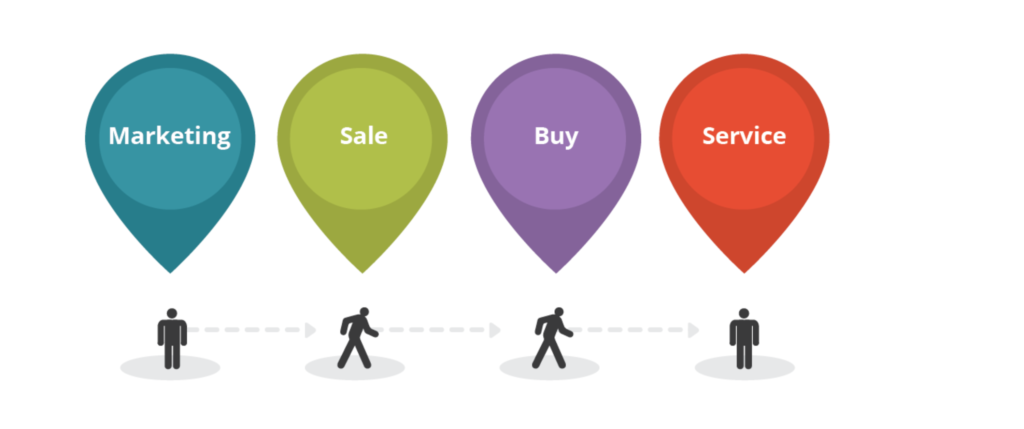When we think about our customer’s journey with us, we have a tendency to over-simplify it and express how we want our customers to interact with us. We represent their experience as a linear journey through marketing and sales on to usage, service and hopefully a repurchase.
This diagram represents the typical sales-funnel approach to our customer’s journey:
If we step out of our own shoes, however, and recognize that our customer’s experience with our firm is not our experience. It is a much more complicated reality that looks more like this:
There are a myriad of touch points that our customers have with our brands. Some of them in the real world, but many of them are digital. Every single customer’s journey is different and unique. Most importantly we have to recognize, accept, and embrace that the customer is in control. They have complete autonomy over their journey. It can be overwhelming to think about all of the possible ways that they interact with our brand.
It is also pompous of us to think that we have any control over the choices that our customers make. If our intent is to build a lifelong mutually beneficial relationship with our customers, then we have to think about their journey a little differently. We have to figure out how to pull them along instead of trying to push them through our funnel as quickly as we can. Our software should recognize and honor their autonomy and respect their time to the greatest degree possible.
In the Loyalty Ladder, I explain how every micro-experience with our brand matters in the evolution of the relationship. The great thing about digital experiences is that they are consistent and scalable. Dollar for dollar, your customer’s digital experience with your brand is a great place to invest your marketing dollars.
Our solution is to think of our customer’s journey in terms of a measurable framework. We can look for the online behaviors that would indicate that they are progressing along the loyalty ladder at the appropriate intervals for our business. We set what we call “Product KPI’s,” or pKPI’s for short, for our engagement platforms to measure the actual behaviors that would indicate a given customer has crossed one of the three thresholds.
- The Trust Threshold. This is the point at which your customer or user decides that they want to do business with us and transacts. It could mean that they actually pull out her wallet and spend money or give us an important piece of data about themselves. For this pKPI, we look for agreement on what transaction or transactions would indicate trust.
- The Loyalty Threshold. This is the point at which your customer or user self determines that they will use your business in the future. This is a key point in the relationship because it indicates that they will not be doing a competitive search. You have earned enough trust through your service delivery that they aren’t even going to look elsewhere. For this pKPI, we look for a measure that would indicate recurring engagement at a proper interval.
- The Advocacy Threshold. This is the point at which your customer actively shares their relationship with your brand publicly in some way. The most obvious example would be an unsolicited Facebook share or like, but a more powerful measure might be an actual referral. For this pKPI we look for consensus on what an advocacy behavior might look like. For some solutions, we have to revert to a survey based tool like an NPS, but we much prefer searching for those behaviors that we can measure.
Once we have baseline measures for the Product KPI’s, we can set goals and targets for our teams to raise the bar on all three of these measures. When we see that any one of the measures is not moving, we can look for the symptoms behind each part of the customer’s journey within the framework and work to evolve and tweak the micro-interactions that we believe will be most impactful. With a solid journey framework in place, your product team will be focused on the right things and working to improve your customer’s actual journey more effectively than ever before.






